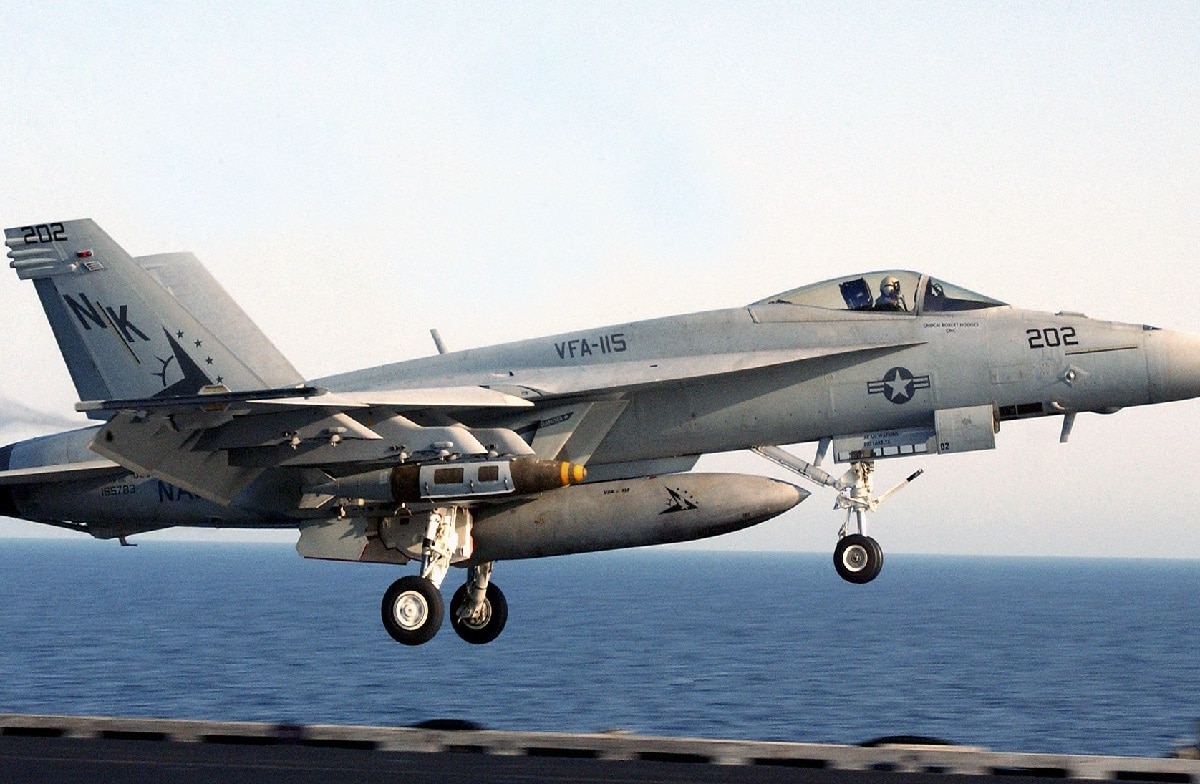In September 2021, aerospace giant Boeing delivered the first of seventy-eight contracted Block III F/A-18 Super Hornets to the U.S. Navy. The Block III was developed to provide the Navy with the most networked and survivable F/A-18 built to date. At the same time, it also devised a technology insertion plan that would allow the carrier-based multirole fighter to outpace future threats.
(Subscribe to Our YouTube Channel Here.)
As the most advanced version of the Super Hornet, the Block III was designed to exceed fourth-generation fighter capabilities. Now the U.S. Navy’s premier fighter, its capabilities include an advanced cockpit system with a 10-inch-by-19-inch touchscreen display, enhanced networking, open mission systems, reduced radar signature, and a 10,000-hour airframe.
“The fleet needs capabilities to keep its edge. Getting the first operational Block III in our hands is a great step forward in supporting our capability and readiness goals,” explained Capt. Jason ‘Stuf’ Denney, U.S. Navy F/A-18 and EA-18G program manager, last year as the Navy took delivery of the first Block III aircraft.
Block III in the Spolight
Block III is equipped with a new adjunct processor that allows the fighter to do more work in far less time, which in turn can increase a pilot’s situational awareness.
The jet is also ready to receive apps-based solutions that will allow upgrades to the aircraft throughout its life span.
“We invested in Block III technology and developed the capabilities in partnership with the U.S. Navy to meet its emerging requirements,” added Jen Tebo, Boeing vice president of F/A-18 and EA-18G programs. “The hardware upgrades are complete. Today we are maximizing the open hardware and software and developing the apps to keep Block III ahead of future threats. We are giving Navy pilots the tools to make the fastest and most informed decisions possible now and in the future.”
Boeing received a $4 billion U.S. Navy contract in March 2020 to produce seventy-eight F/A-18 Block III Super Hornets, which will be delivered to the Navy by the end of 2024. Of these, sixty-one will be the single-seat E variant while seventeen will be the two-seat F model.
The aerospace company will also continue to support the Block III capabilities and upgrades through the mid-2030s from three production lines, including one for new builds – while two others will provide Service Life Modification to extend the life of the aircraft and upgrade Block II Super Hornets to Block III.
Long-Flying Super Hornet
The F/A-18E/F Super Hornet first entered fleet service in 1999, as the replacement for the F-14 Tomcat. It is the second major model upgrade since the inception of the F/A-18 aircraft program in the early 1980s. It was developed to be highly capable across the full mission spectrum: air superiority, fighter escort, reconnaissance, aerial refueling, close air support, air defense suppression, and day/night precision strike.
The Block III will extend the fighter’s life from 6,000 to 10,000 hours. It conducted its first flight in May 2020, and its capability upgrades include enhanced network capability, longer range, reduced radar signature, an advanced cockpit system, and an enhanced communication system. With these enhancements, the Super Hornet will remain in service for decades to come.

PACIFIC OCEAN (Feb. 26, 2017) An F/A-18E Super Hornet assigned to the “Eagles” of Strike Fighter Squadron (VFA) 115 conducts aerial refueling operations with a U.S. Air Force KC-10A Extender. VFA-115 is traveling from Naval Air Facility Atsugi, Japan, to Naval Air Station Fallon, Nevada, to complete the strike fighter advanced readiness program. (U.S. Navy photo by Lt. Chris Pagenkopf/Released)170226-N-CF980-006

An F/A-18F Super Hornet Strike Fighter Squadron 103 is parked on the flight deck of the aircraft carrier USS Dwight D. Eisenhower (CVN 69) as the ship operates in the Arabian Sea on Dec. 5, 2006. The Eisenhower is in the Arabian Sea in support of maritime security operations.

ARABIAN GULF (Sept. 11, 2014) Sailors direct an F/A-18E Super Hornet attached to the Tomcatters of Strike Fighter Squadron (VFA) 31 on the flight deck of the aircraft carrier USS George H.W. Bush (CVN 77). George H.W. Bush is supporting maritime security operations and theater security cooperation efforts in the U.S. 5th Fleet area of responsibility. (U.S. Navy photo by Mass Communication Specialist 3rd Class Joshua Card/Released) 140911-N-CZ979-008

Image: Creative Commons.
No wonder the F/A-18 was featured in the new Top Gun movie.
A Senior Editor for 19FortyFive, Peter Suciu is a Michigan-based writer. He has contributed to more than four dozen magazines, newspapers, and websites with over 3,000 published pieces over a twenty-year career in journalism. He regularly writes about military hardware, firearms history, cybersecurity, and international affairs. Peter is also a Contributing Writer for Forbes and Clearance Jobs. You can follow him on Twitter: @PeterSuciu.

